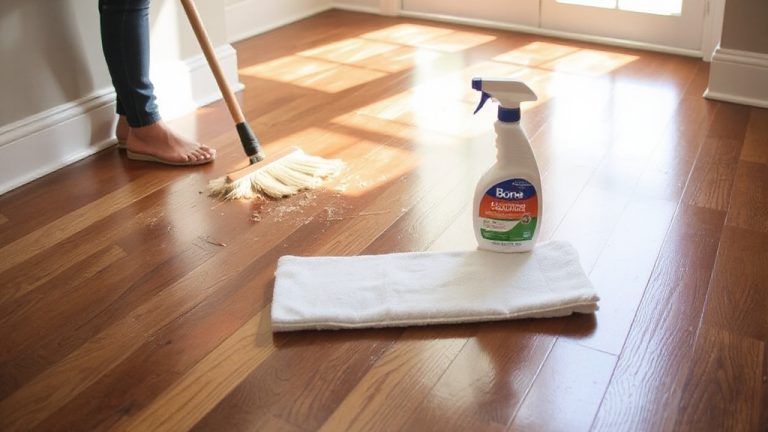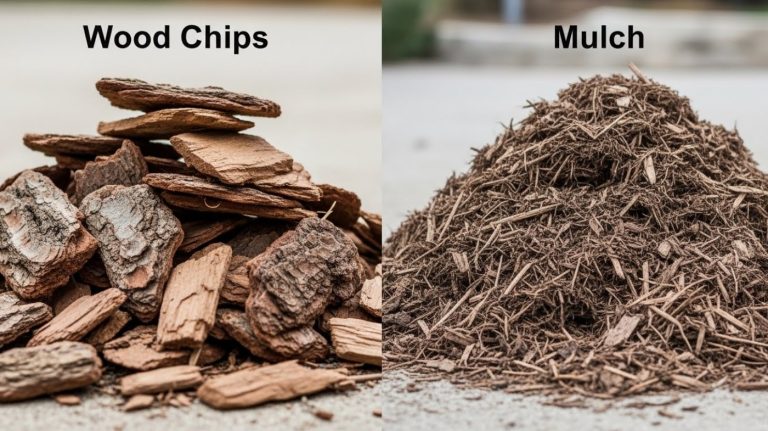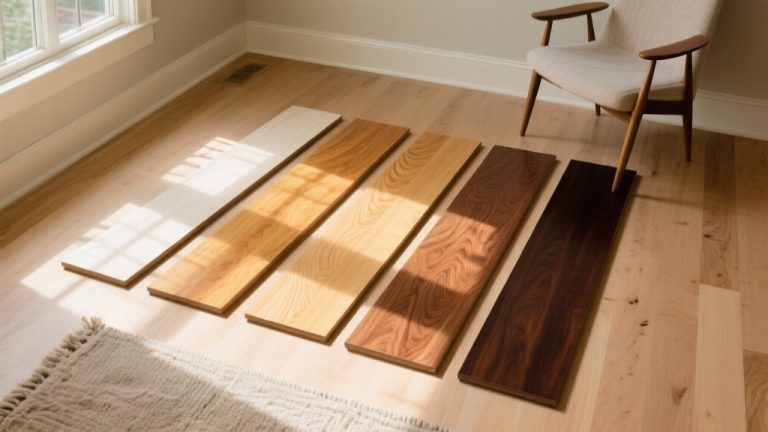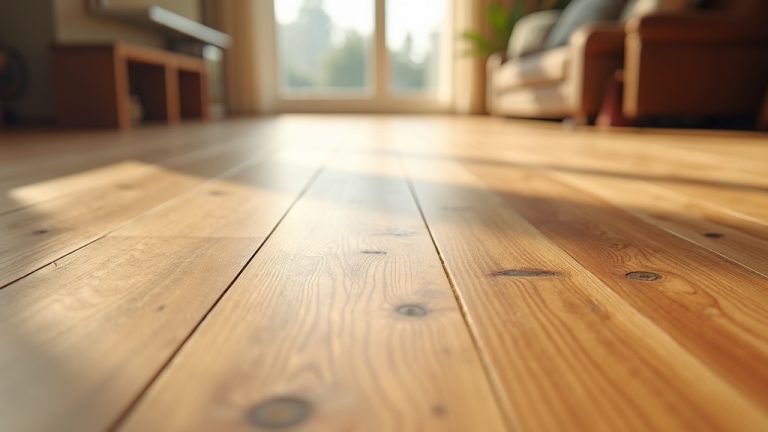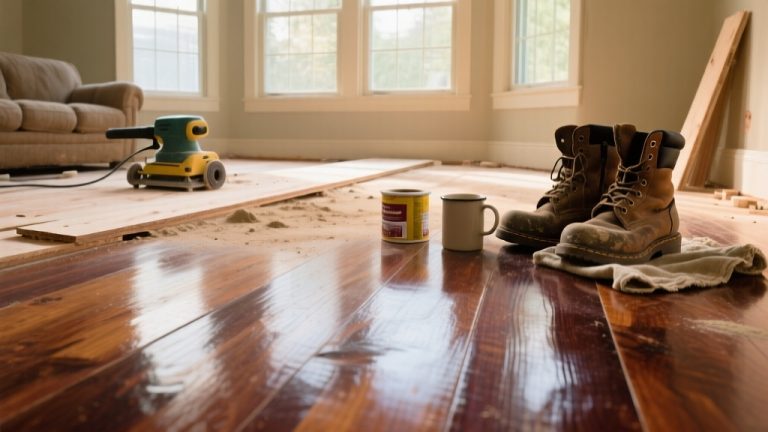When choosing between satin and semi-gloss hardwood floors, satin offers you a soft, warm glow that gently masks imperfections and hides scratches, creating a cozy, inviting space.
Semi-gloss brings out rich wood grain with a brighter, polished shine, perfect for formal, vibrant rooms but requires more upkeep to maintain its crisp look.
Both are durable with proper care, but your choice shapes the room’s mood and maintenance. If you want to explore how these finishes transform your space further, keep going.
Key Takeaways
- Satin finish offers a low-sheen, matte look that masks scratches and dust, creating a cozy, glare-free environment ideal for busy living areas.
- Semi-gloss provides a brighter, reflective surface that highlights wood grain and color richness, suitable for formal or design-focused spaces.
- Satin floors require less maintenance and better conceal imperfections, while semi-gloss demands more upkeep due to visible scratches and blemishes.
- Proper application includes multiple thin coats with sanding between layers, with satin using moderate build and semi-gloss, thicker layers for enhanced luster.
- Satin is preferred for everyday, high-traffic rooms; semi-gloss suits low-traffic, elegant spaces needing a polished, vibrant wood appearance.
Comparison Table Between Satin & Semi-Gloss Hardwood Floor Finishes
| Aspect | Satin Finish | Semi-Gloss Finish |
|---|---|---|
| Sheen & Look | Soft, matte glow that gently masks imperfections | Bright, polished shine that highlights the wood grain |
| Imperfection Masking | Hides scratches and dust; ideal for busy areas | Shows scratches easily; better maintained in low-traffic spaces |
| Maintenance | Lower upkeep; conceals wear | Requires frequent cleaning and touch-ups to retain crisp shine |
| Atmosphere | Creates a cozy, inviting vibe | Delivers a formal, vibrant ambiance |
| Best Spaces | Living rooms, entryways, home offices | Formal living rooms, dining rooms, showrooms |
| Durability | Durable and forgiving | Durable but visibly ages with wear |
| Slip Resistance | Slightly higher traction due to lower sheen | More slippery when wet because of higher reflectivity |
| Product Types | Oil-modified urethane, water-based poly; available in many species and plank sizes | Similar product options but often in fewer sheen levels |
| Recoating Interval | Typically recoats every 8–10 years depending on wear | Typically recoats every 5–7 years to maintain shine |
Sheen and Appearance Differences
When deciding between satin and semi-gloss hardwood floors, understanding their sheen and appearance differences is key to achieving your desired look.
Satin offers a low-sheen, matte finish that softly mutes wood grain and color, creating a warm, cozy atmosphere. It enhances your floor’s natural texture with a subtle glow, concealing minor imperfections and providing a classic, understated elegance.
The low gloss level of satin also helps to minimize light reflection, making it ideal for rooms with natural lighting. Additionally, satin finishes tend to be more forgiving when it comes to hiding surface stains and dark spots.
In contrast, semi-gloss shines with 45-55% luster, doubling satin’s brightness for a polished, reflective surface. This finish vividly highlights wood grain and color richness, lending a striking, sophisticated vibe ideal for formal spaces.
Semi-gloss floors play dynamically with light, shifting wood tones throughout the day, while satin maintains a consistent, gentle appearance. Your choice depends on whether you prefer subtle warmth or a vibrant, eye-catching sheen.
Durability and Maintenance Considerations
Although semi-gloss finishes offer stronger protection against surface abrasions and dents, satin hardwood floors excel at masking scratches and wear.
This makes them a smart choice if you prefer a floor that ages gracefully without demanding constant upkeep. Proper cleaning using gentle cleaning solutions ensures the finish remains intact while maintaining its appearance.
Satin’s matte surface softens imperfections, hiding dust and minor damage, so you won’t need to clean or polish as often. While semi-gloss floors shine brighter, they reveal scratches and blemishes more easily, requiring more frequent maintenance to keep that polished look.
Satin finishes typically have a luster rating of 35-40%, providing a moderate shine that balances appearance and maintenance. Satin finishes, however, may be slightly less abrasion-resistant and need careful handling during refinishing to avoid a muddy appearance.
Ultimately, if you want durability with subtle resilience and less maintenance hassle, satin floors beautifully balance protection and practicality for your living space.
Aesthetic and Style Impacts
You’ll notice satin floors offer a soft, muted glow that enhances wood’s natural beauty without overwhelming your space. This finish is known for its low-sheen surface that balances elegance and practicality.
In contrast, semi-gloss finishes bring out vivid grain details with a brighter, reflective shine that suits more formal or luminous interiors. Choosing between them shapes not just your floor’s look but the entire room’s style and mood.
Satin finishes provide a soft sheen that adds elegance without excessive shine, making them a versatile choice for many design aesthetics.
Sheen and Visual Appeal
Since the sheen level dramatically influences your floor’s visual impact, choosing between satin and semi-gloss finishes shapes the entire room’s atmosphere.
Satin offers a soft, matte look, reflecting less light to highlight your wood’s natural grain and texture without glare. It creates a warm, inviting mood, perfect for cozy, lived-in spaces.
Satin finishes show scratches less easily than higher gloss finishes, making them a practical choice for many homeowners’ scratch resistance. Additionally, satin finishes can be enhanced using gel stain to provide better coverage and control during refinishing.
Semi-gloss, on the other hand, doubles the reflectivity, bouncing 45–55% of light to brighten and open up rooms, lending a polished, sophisticated vibe. However, its shine reveals every scratch and dust particle, demanding more upkeep.
Satin’s subdued sheen conceals imperfections and reduces glare, making it practical for busy areas. Your choice will define how light interacts with your floors, influencing both ambiance and maintenance needs.
Style Compatibility Choices
The way your hardwood floor finish interacts with light sets the tone, but the style of your space ultimately guides which sheen suits best.
If you favor traditional or classic designs, satin brings understated elegance and soft light diffusion, perfect for cozy, ambient rooms and masking imperfections in antique floors. Satin finishes offer a balanced sheen suitable for various settings.
Additionally, the choice between satin and semi-gloss can influence how environmental conditions affect the durability and maintenance of your floor finish.
Semi-gloss, meanwhile, highlights rich grain details and suits formal spaces needing a polished, refined look. For modern, minimalist interiors, satin’s low sheen complements muted finishes and cool palettes, creating a seamless, natural vibe.
Semi-gloss adds crispness and essentiality, enhancing sharp lines and reflective surfaces. Consider your lifestyle: satin hides wear better for active homes, while semi-gloss demands more upkeep but offers vibrant brightness.
Best Uses by Space and Traffic Level
Although both satin and semi-gloss hardwood floors bring unique charm to your home, choosing the right finish depends greatly on the space’s function and foot traffic.
Satin works beautifully in living rooms, bedrooms, and family areas where moderate traffic and a soft, glare-free look matter. It’s perfect if you want to hide scratches and dust while keeping a cozy atmosphere.
Moreover, satin finishes offer a longer lifespan than semi-gloss or glossy options, making them a durable choice for everyday living spaces. When installing, consider proper measurement to ensure your flooring height matches surrounding surfaces seamlessly.
Semi-gloss shines in formal dining rooms or entryways with low to moderate traffic, offering a bright, elegant appeal but needing more upkeep.
| Space Type | Satin Finish | Semi-Gloss Finish |
|---|---|---|
| Living Room | Soft matte look; hides wear and dust | Bright and reflective; highlights grain |
| Entryway | Masks imperfections; durable for traffic | Gleaming, formal; shows scratches easily |
| Home Office | Understated, professional, low glare | Vibrant finish; best for low traffic |
Application Techniques and Coating Details
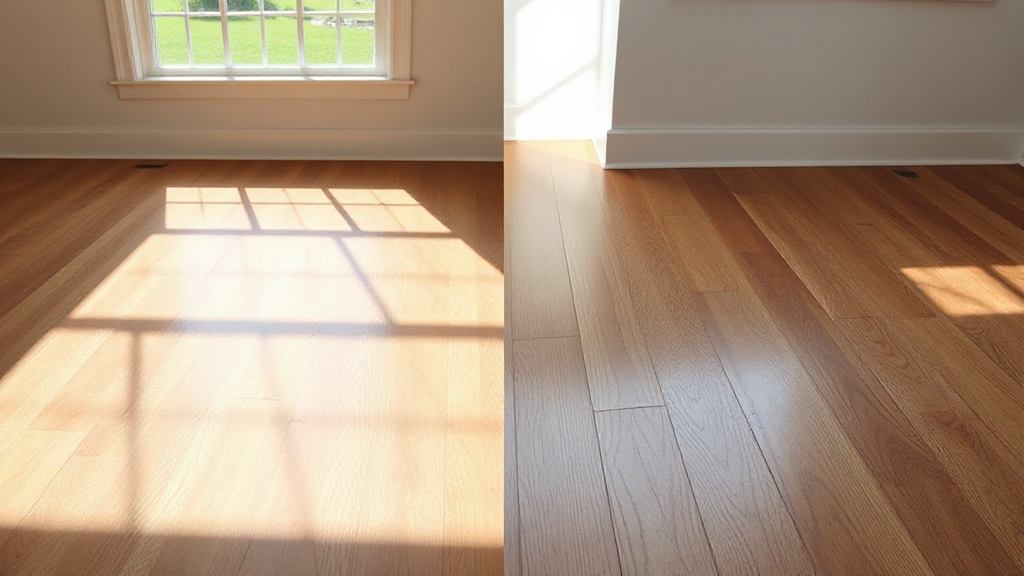
You’ll want to start with meticulous surface preparation—cleaning and sanding—to guarantee every layer adheres flawlessly. Applying multiple thin coats with high-quality tools lets the finish build depth without streaks or bubbles.
Between each coat, light sanding refines the texture, enhancing both durability and the beauty of your chosen satin or semi-gloss sheen. Choosing the right finish thickness is crucial, as a thicker wear layer can significantly improve the floor’s longevity and resistance to damage.
Surface Preparation Essentials
When preparing your hardwood floors for finishing, meticulous surface cleaning and dust removal become essential steps to achieve a flawless, durable look. You’ll want to vacuum thoroughly after sanding and follow up with a damp mop or tack cloth to catch any lingering fine dust.
Pay special attention to corners and edges, ensuring no debris remains to interfere with adhesion. Using high-quality abrasives during sanding ensures a professional finish and preserves the integrity of the wood surface.
Additionally, performing necessary repair work such as fixing scratches or water damage before finishing helps create a smooth and lasting surface. Also, sealing air vents and maintaining good ventilation accelerates drying and prevents dust recirculation.
Key surface preparation essentials include:
- Sand progressively from coarse to fine grit, always with the grain, to create a smooth, uniform base.
- Fill gaps and imperfections with color-matched wood fillers, letting them cure fully before resanding.
- Maintain a clean, controlled environment, free of contaminants and ideal temperature and humidity for finish application.
Coating Application Methods
With your hardwood floor perfectly prepped, the way you apply the finish will define the final look and durability.
Start by pouring a six-inch puddle of water-based polyurethane near the wall. Use a wetted lambswool applicator or weighted T-bar, spreading the finish evenly in smooth strokes along the wood grain. Stage all materials on a trash bag to prevent floor damage and ensure accessibility.
Regularly vacuum hardwood floors beforehand can help reduce dust that may settle on the finish. Cut in by hand first to maintain a wet edge and avoid lap marks. Apply thin coats at 600-700 square feet per gallon, avoiding over-brushing or shaking to prevent bubbles.
Keep the environment between 60-80°F with low humidity, and guarantee proper ventilation without direct sunlight. Allow 1-2 hours drying time between coats, applying no more than two daily.
Buff between coats with a Norton Green SandDollar disk and a 3M white Scotch-Brite pad to ensure a smooth surface and better adhesion. Light sanding or screening between coats enhances adhesion, preserving your floor’s flawless satin or semi-gloss beauty.
Finish Layering Effects
Although both satin and semi-gloss finishes protect your hardwood floors, the way you layer each coat dramatically shapes their visual and functional qualities.
Satin finishes apply a moderate build, softly masking imperfections with a muted sheen. Semi-gloss layers are thicker, enhancing durability and reflectivity. Satin finish is known to camouflage imperfections better, which makes minor dents and scratches less noticeable.
Proper layering techniques and sanding between coats are essential for achieving a professional finish without damage to adjacent surfaces. You’ll notice that semi-gloss demands more precise application to avoid highlighting flaws due to its higher shine.
Consider these key layering effects:
- Satin’s 2-3 coats create a smooth, subtle luster that conceals minor scratches and softens room lighting.
- Semi-gloss builds a glossier surface reflecting 45-55% light, emphasizing wood grain and color depth.
- Both finishes require careful sanding between layers to ensure a flawless, uniform appearance without cloudiness.
Market Availability and Product Choices
Since your choice of hardwood finish greatly influences both the look and upkeep of your floors, understanding market availability and product options is essential.
Satin finishes dominate the market, offering versatility and a matte to mildly glossy look that masks imperfections. Satin finishes provide around 35-40% luster, balancing sheen and practicality. Semi-gloss options, while less common, provide a brighter, shinier surface ideal for formal spaces.
Both finishes come in engineered and solid hardwood variants, with satin favored for high-traffic areas and semi-gloss for design-focused rooms.
| Finish Type | Availability | Key Features |
|---|---|---|
| Satin | Widely available | Matte sheen, hides scratches, durable |
| Semi-Gloss | Common but less prevalent | Shiny, highlights grain, needs upkeep |
| Product Types | Oil-modified urethane, water-based polyurethane | Variety in species and plank sizes |
Frequently Asked Questions
Can Satin or Semi-Gloss Finishes Be Refinished at Home?
You can absolutely refinish your hardwood floors at home, whether satin or semi-gloss. It takes careful sanding, cleaning, and applying quality polyurethane for a flawless finish. Satin’s matte look hides minor flaws, making it more forgiving if you’re new to refinishing.
Semi-gloss demands precision—any imperfections will show. Remember to wear protective gear, work in a well-ventilated space, and allow proper drying time between coats to achieve stunning results.
How Long Does Each Finish Typically Last Before Recoating?
You can expect your hardwood floor finish to last about 3 to 5 years before it needs recoating. This timeframe depends on your foot traffic and how well you maintain it.
Regular cleaning and protecting against moisture help extend that lifespan. Keep an eye out for dullness, scratches, or water absorption—they’re signs it’s time to refresh the finish and restore your floor’s beautiful shine and protection.
Are There Eco-Friendly Options for Satin or Semi-Gloss Finishes?
Oh sure, why not coat your floors in toxic fumes while you’re at it? But seriously, you don’t have to sacrifice style for sustainability.
You can choose water-based or plant-based polyurethane finishes that deliver stunning satin or semi-gloss sheens without the nasty chemicals. These eco-friendly options highlight wood’s natural beauty, dry fast, and keep your indoor air fresh—perfect for your health-conscious, design-savvy lifestyle.
Do These Finishes Affect the Floor’S Slip Resistance?
Yes, the finish you choose considerably impacts slip resistance. Satin finishes offer better traction with their subtle sheen and textured surface that hides dirt and reduces glare, making them safer underfoot.
Semi-gloss, while more lustrous, reflects more light and can feel slippery, especially in bright rooms. If you want to balance style and safety, satin’s muted elegance helps maintain grip without compromising your floor’s beauty.
Can Pets’ Nails Damage Satin or Semi-Gloss Hardwood Finishes Differently?
You’ll find that pet nails can scratch any hardwood finish, but satin hides those tiny marks better thanks to its muted sheen. Semi-gloss, with its shinier surface, tends to spotlight scratches and imperfections more, making wear from claws more visible.
To keep your floors looking flawless, regularly trim your pet’s nails and use rugs in high-traffic areas. This way, you protect your investment while embracing your pet-friendly lifestyle beautifully.
The Mood Maker: Floor Finish Choice Shapes the Room’s Feel
When choosing between satin and semi-gloss hardwood floors, you’ll want to contemplate how light interacts with each sheen to complement your space’s vibe.
Satin offers a subtle, timeless elegance like a treasured pocket watch, while semi-gloss brings a lively, reflective charm that highlights your wood’s natural beauty.
Think about your lifestyle, traffic levels, and maintenance preferences to select the perfect finish that elevates your home’s aesthetic with both style and practicality.


